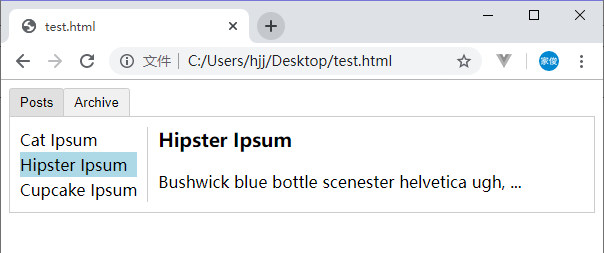您好,登录后才能下订单哦!
密码登录
登录注册
点击 登录注册 即表示同意《亿速云用户服务条款》
Vue中动态组件和异步组件的区别是什么?相信很多没有经验的人对此束手无策,为此本文总结了问题出现的原因和解决方法,通过这篇文章希望你能解决这个问题。
<!DOCTYPE html>
<html>
<head>
<meta charset="utf-8">
<style>
#app {
font-size: 0
}
.dynamic-component-demo-tab-button {
padding: 6px 10px;
border-top-left-radius: 3px;
border-top-right-radius: 3px;
border: 1px solid #ccc;
cursor: pointer;
margin-bottom: -1px;
margin-right: -1px;
background: #f0f0f0;
}
.dynamic-component-demo-tab-button.dynamic-component-demo-active {
background: #e0e0e0;
}
.dynamic-component-demo-tab-button:hover {
background: #e0e0e0;
}
.dynamic-component-demo-posts-tab {
display: flex;
}
.dynamic-component-demo-tab {
font-size: 1rem;
border: 1px solid #ccc;
padding: 10px;
}
.dynamic-component-demo-posts-sidebar {
max-width: 40vw;
margin: 0 !important;
padding: 0 10px 0 0 !important;
list-style-type: none;
border-right: 1px solid #ccc;
line-height: 1.6em;
}
.dynamic-component-demo-posts-sidebar li {
white-space: nowrap;
text-overflow: ellipsis;
overflow: hidden;
cursor: pointer;
}
.dynamic-component-demo-active {
background: lightblue;
}
.dynamic-component-demo-post-container {
padding-left: 10px;
}
.dynamic-component-demo-post > :first-child {
margin-top: 0 !important;
padding-top: 0 !important;
}
</style>
<script src="https://cdn.jsdelivr.net/npm/vue/dist/vue.js"></script>
</head>
<body>
<div id="app">
<button v-for="tab in tabs" class="dynamic-component-demo-tab-button"
v-bind:class="{'dynamic-component-demo-active': tab === currentTab}"
@click="currentTab = tab">{{ tab }}</button>
<keep-alive>
<component v-bind:is="currentTabComponent"></component>
</keep-alive>
</div>
<script>
Vue.component('tab-posts', {
data: function(){
return {
posts: [
{id: 1, title: 'Cat Ipsum', content: 'Cont wait for the storm to pass, ...'},
{id: 2, title: 'Hipster Ipsum', content: 'Bushwick blue bottle scenester ...'},
{id: 3, title: 'Cupcake Ipsum', content: 'Icing dessert souffle ...'},
],
selectedPost: null
}
},
template: `<div class="dynamic-component-demo-posts-tab dynamic-component-demo-tab">
<ul class="dynamic-component-demo-posts-sidebar">
<li v-for="post in posts"
v-bind:key="post.id"
v-on:click="selectedPost = post"
v-bind:class="{'dynamic-component-demo-active': post===selectedPost}">
{{ post.title }}
</li>
</ul>
<div class="dynamic-component-demo-post-container">
<div v-if="selectedPost" class="dynamic-component-demo-post">
<h4>{{ selectedPost.title }}</h4>
<div v-html="selectedPost.content"></div>
</div>
<strong v-else>
Click on a blog title to the left to view it.
</strong>
</div>
</div>`
});
Vue.component('tab-archive', {
template: '<div class="dynamic-component-demo-tab">Archive component</div>'
});
new Vue({
el: '#app',
data: {
currentTab: 'Posts',
tabs: ['Posts', 'Archive']
},
computed: {
currentTabComponent: function(){
return 'tab-' + this.currentTab.toLowerCase()
}
}
});
</script>
</body>
</html>
在动态组件上使用keep-alive,可以在组件切换时保持组件的状态,避免了重复渲染的性能问题。
Vue 允许你以一个工厂函数的方式定义你的组件,这个工厂函数会异步解析你的组件定义。
Vue.component('async-example', function (resolve, reject) {})这里可以回顾一下 Vue.js — 组件基础。
我们使用通过webpack打包的Vue项目来介绍异步组件。
<!-- HelloWorld.vue -->
<template>
<div>
<h3 class="title">{{msg}}</h3>
</div>
</template>
<script>
export default {
data () {
return {
msg: 'Hello Vue!'
}
}
}
</script>
<!-- Add "scoped" attribute to limit CSS to this component only -->
<style scoped>
.title {
padding: 5px;
color: white;
background: gray;
}
</style>
<!-- App.vue -->
<template>
<div id="app">
<HelloWorld/>
</div>
</template>
<script>
import HelloWorld from './components/HelloWorld'
export default {
name: 'App',
components: {
HelloWorld
}
}
</script>
<style>
</style>我们把App.vue的<script>标签里面的内容改为:
export default {
name: 'App',
components: {
HelloWorld: () => import('./components/HelloWorld')
}
}这样就实现了App组件异步加载HelloWorld组件的功能。
我们可以实现按需加载。
<!-- App.vue -->
<template>
<div id="app">
<button @click="show = true">Load Tooltip</button>
<div v-if="show">
<HelloWorld/>
</div>
</div>
</template>
<script>
export default {
data: () => ({
show: false
}),
components: {
HelloWorld: () => import('./components/HelloWorld')
}
}
</script>
<style>
</style>这里的异步组件工厂函数也可以返回一个如下格式的对象:
const AsyncComponent = () => ({
// 需要加载的组件 (应该是一个 `Promise` 对象)
component: import('./MyComponent.vue'),
// 异步组件加载时使用的组件
loading: LoadingComponent,
// 加载失败时使用的组件
error: ErrorComponent,
// 展示加载时组件的延时时间。默认值是 200 (毫秒)
delay: 200,
// 如果提供了超时时间且组件加载也超时了,
// 则使用加载失败时使用的组件。默认值是:`Infinity`
timeout: 3000
})看完上述内容,你们掌握Vue中动态组件和异步组件的区别是什么的方法了吗?如果还想学到更多技能或想了解更多相关内容,欢迎关注亿速云行业资讯频道,感谢各位的阅读!
免责声明:本站发布的内容(图片、视频和文字)以原创、转载和分享为主,文章观点不代表本网站立场,如果涉及侵权请联系站长邮箱:is@yisu.com进行举报,并提供相关证据,一经查实,将立刻删除涉嫌侵权内容。